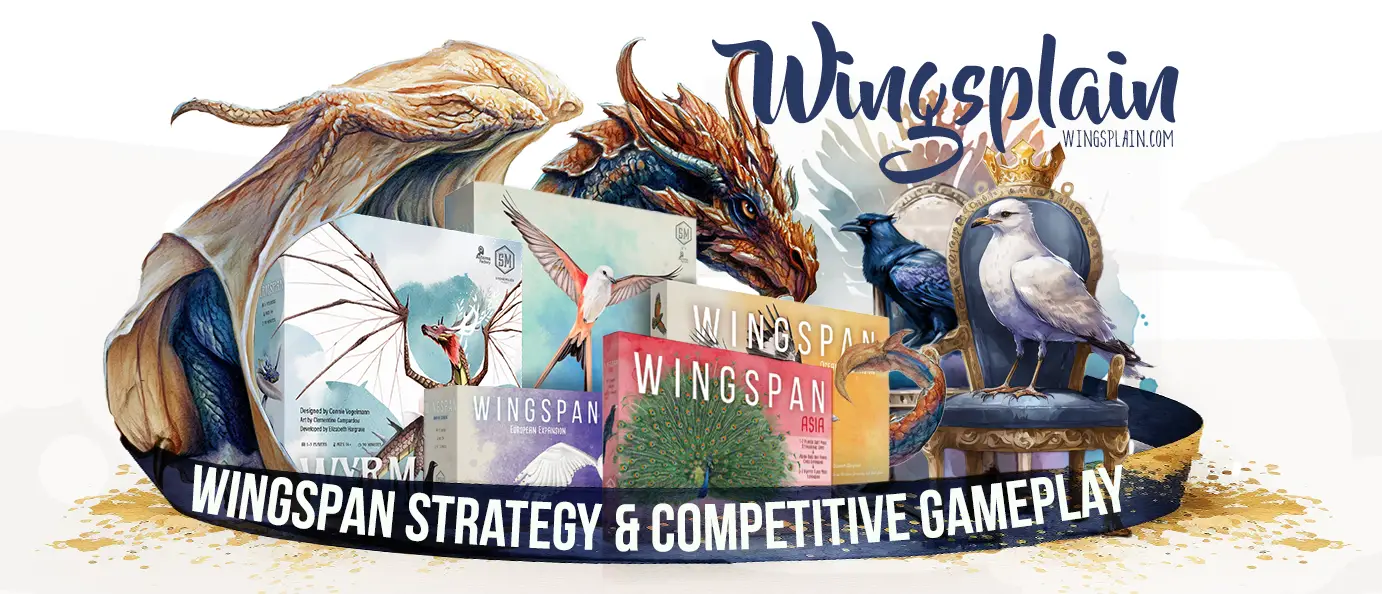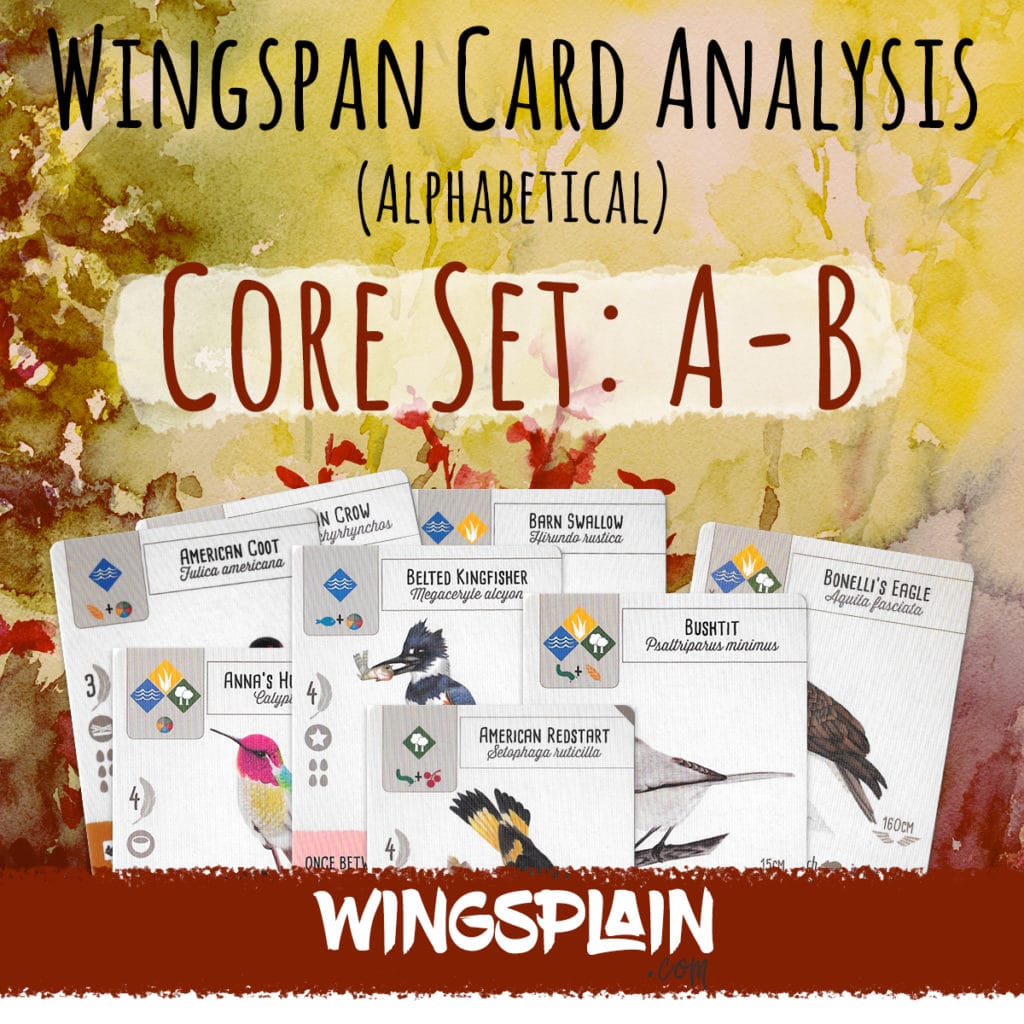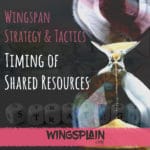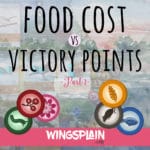Alphabetical Card Analysis is a series of posts that break down the good and the bad of each Wingspan card in a succinct manner. This first post includes the cards that begin with A and B from the Core Set plus the Swift Start Pack.
Wingspan Cards Core Set: A
Acorn Woodpecker
It costs three seeds and is restricted to the Forest. Five victory points and a four egg nest don’t seem great for the cost. Its power is limited to a single common food type, and it is flexible in that it offers a choice to gain or cache.
American Avocet
It feels overpriced in practice. Three food for a six-point bomb with a two-egg nest isn’t great for the cost compared to other options. Its power is ok. You need another bird with a specific nest type to adequately support it. It really needs a cooperative opponent to feel useful.
American Bittern
It has a small, two-egg nest and limited power. At seven victory points, it’s only really useful as a point bomb.
American Coot
A good tuck/draw bird. Has a moderate and flexible food cost for a three victory point bird and a large five egg nest. Makes a great egg bank. Omnivore Specialist and Bird Counter make it better by adding two points each.
American Crow
Tri-habitat with cheap and flexible food cost. Fits into the “Hummingbird archetype” in this regard. Its power is half a Raven which makes a noticeable difference. I have found that it can still be an effective source of food in the Grasslands, especially when paired with a Hummingbird. Omnivore Specialist makes this a very efficient point bomb by tacking on two points.
American Goldfinch
If you have two seeds in your supply, this card pretends to cost zero food, and its power essentially reads, “When Played: You gain one seed from the general supply.” This card’s qualities aren’t worth paying for.
American Kestrel
Mediocre general qualities with a bad power. This card is only valuable if you have Falconer and/or Rodentologist.
American Oystercatcher
There are times when this power can be useful, but it does give cards to your opponents. You get the best and worst pick. Otherwise, it has poor general qualities for the price of two food. It makes a good point bomb if you have Food Web Expert.
American Redstart
An excellent early game food accelerator. It could be considered a variant of the “Hummingbird archetype.” Not giving food to your opponents restricts this bird to the forest and increases its food cost to one worm and one fruit.
American Robin
This tuck draw bird is hard to support because it can’t be played in the Wetlands, decreasing its value. At one food cost, it could be a decent egg bank option (four-egg nest) if you need egg capacity immediately. Bird Counter adds two points to this play.
American White Pelican
A classic archetype. If this Wingspan Card has direct fish support, it can generate a lot of points. It becomes a good point bomb if you have Bird Counter. On its own, it is mediocre.
American Woodcock
Classic point bomb.
Anhinga
Mediocre general qualities with a bad power. It becomes a good point bomb if you have Falconer.
Anna’s Hummingbird
The classic Hummingbird archetype. It’s incredibly flexible in habitat placement and food cost. It can make the impossible possible by gaining food from the Grasslands or Wetlands. Omnivore Specialist gives it amazing value.
Ash-Throated Flycatcher
With the right number of the appropriate nests on the board, this can be a great late-game point bomb.
Atlantic Puffin
The big point bomb of the bonus card birds. Its star nest is kind of pointless since it can only hold one egg. With a lucky draw, this can be a gigantic point bomb—the best of its archetype.
Wingspan Cards Core Set: B
Baird’s Sparrow
It has a handy brown power, but it’s overpriced for its archetype. It doesn’t compare to Chipping Sparrow. Being able to lay eggs on any bird keeps it desirable—still a good early gameplay.
Bald Eagle
A point bomb that can sometimes get you fish, potentially reducing its net cost by sixty-six percent. It’s best to time this when you can get a reroll of the bird feeder out of it to maximize fish gains. Rodentologist makes this an even bigger bomb by adding two points.
Baltimore Oriole
A point bomb with a two-egg start nest. Its power is kind of a moot point but can be handy if you really need the extra fruit.
Barn Owl
Solid general qualities and a bad power. It becomes a good point bomb with a four-egg nest if you have Falconer and/or Rodentologist.
Barn Swallow
A cheap Tuck/Draw bird. Its three-egg star nest is nice. It goes in the correct habitat (Wetlands). Bird Counter adds two points to this play.
Barred Owl
Poor general qualities and a power that is at the bottom of its archetype. It becomes a good play with either Falconer and/or Rodentologist, making it worth at least five points for one food.
Barrow’s Goldeneye
It feels overpriced in practice. Three food for a five-point play with a four-egg nest feels subpar. There is plenty of five-point, four-egg birds that cost two food (then again, there are plenty of these birds that cost three food as well). Its power is ok. You need another bird with a specific nest type to adequately support it. It really needs a cooperative opponent to feel useful.
Bell’s Vireo
Classic bonus card bird. A two-egg star nest is icing on the cake. Food Web Expert makes it worth two more points.
Belted Kingfisher
Moderate and flexible food costs. A good egg bank at four victory points and a four-egg start nest. Its fish generating pink power is an afterthought. Omnivore Specialist makes this a very solid play by tacking on two points.
Bewick’s Wren
The migrator archetype is generally overpriced. This is no exception. This is a weak Wingspan card.
Black Skimmer
Mediocre general qualities with a bad power. It becomes a good point bomb if you have Falconer.
Black Tern
The cheap, flexible food cost for four victory points and a two-egg star nest is decent. Its power is weak, but it does let you look at and cycle cards.
Black Vulture
Zero food cost, but its general qualities are poor as a result. Its power is limited. Don’t play this unless you know your opponents will be leaning on their predators consistently.
Black-Bellied Whistling Duck
Makes a great egg bank. Classic archetype. Can score a lot of points if properly supported with seeds. Bird Counter makes it better by adding two points.
Black-Billed Magpie
It feels like a better Vulture. It costs two food, but it’s wild, and its three-egg start nest can be handy. Omnivore Specialist adds two more points to it. Gets you 50% of the birds needed for Anatomist and Prairie Manager.
Black-Chinned Hummingbird
The classic Hummingbird archetype. It’s incredibly flexible in habitat placement and food cost. Off-habitat fruit can be useful, but this Hummingbird’s power isn’t as useful as its brethren’s. Omnivore Specialist gives it an amazing value.
Black-Crowned Night-Heron
A Crow on steroids. A point bomb with a sometimes useful power.
Black-Necked Stilt
Several birds have better card drawing powers, better general qualities, and better food costs than this. It does qualify for Food Web Expert, which adds two points to it. It doesn’t feel as good as Carolina Wren, which serves as a great early game egg bank for 50% of the food cost (but with a 75% victory point reduction).
Blue Grosbeak
The migrator archetype is generally overpriced. This is no exception. This is a weak Wingspan card.
Blue Jay
This card feels subpar in practice. It does provide the flexibility of caching or taking the food, but it must be available in the birdfeeder. Omnivore Specialist makes it more palatable by tacking on two points.
Blue-Gray Gnatcatcher
A cheap and effective early game food fixer. Food Web Expert makes it worth two more points.
Blue-Winged Warbler
An eight-point bomb for only a two food cost. It breaks the mold in this regard.
Bobolink
This can be a great late-game point bomb with the right nest setup.
Brant
Its general qualities are poor, but its unique power could come in handy in certain situations. You get to draw three cards, and since they are from the bird tray, you can optimize your timing. Omnivore Specialist makes it better by adding two victory points.
Brewer’s Blackbird
Classic Tuck/Lay archetype. It’s difficult to support since it is restricted to the Grasslands. Another bird that benefits from Omnivore Specialist. Bird Counter also tacks another two points onto it.
Broad Winged Hawk
One food for a four-point two-egg bird isn’t bad (Hummingbird Archetype). Its power is bad. Like many birds of prey, it falls under the large umbrella of Falconer, Rodentologist, Platform Builder, and Large Bird Specialist.
Bronzed Cowbird
Combos very well with early game accelerators with cup nests. Twice the cost of its little brother, Brown-Headed Cowbird, but it’s worth two more victory points.
Brown Pelican
If you have two fish in your supply, this card pretends to cost zero food, and its power essentially reads, “When Played: You gain one fish from the general supply.” This card’s qualities aren’t worth paying for.
Brown-Headed Cowbird
Better than Bronzed Cowbird by virtue of being half the cost. Combos very well with early game accelerators with cup nests.
Burrowing Owl
Five victory points and a four-egg star nest for two food is a good combination. Its power is poor. Like most predators, it falls under the large umbrella of Falconer, Rodentologist, and Platform Builder.
Bushtit
A Tri-Habitat Tuck/Lay bird with a five-egg star nest. These qualities let it make a large impact on egg-based end-of-round goals. Bird Counter adds two points to it. Works best in the Wetlands, where the habitat supplies the fuel for its power.
Next: Alphabetical Wingspan Card Analysis: Core Set (C-H)
Want More Wingspan Card Breakdowns?
Follow our blog for instant email notification when the next batch is published! You’ll find the subscription form in the right sidebar. —>
Please leave your comments below. We welcome constructive comments on all of our posts and enjoy talking about Wingspan with the community.




I think Vulture is “fine” if you pick it up in your opening hand or the first couple of turns. You can use it to get an extremely fast level 2 forest with something like turn 1 forest bird, turn 2 lay eggs, turn 3 vulture. Being able to get 2 food per forest activation by turn three is quite solid, even if the pink ability doesn’t go off.
That being said, vultures have a very tight “deadline”. I would say that if you see them after mid-round 1 they are no longer worth the turn to put them down.
The refund birds are kind of similar, but are much harder to cast and are therefore much worse.
Vultures are “fine” in my opinion. If you pick one up in your opening hand or in the first few turns, you can turbo out level 2 woodlands very quickly, allowing you to pick up 2 food per activation. Something like woodlands bird, lay eggs, vulture gets you there by turn 3 with only 1 or 2 food, and that’s a pretty big deal. That being said, they do have a VERY hard deadline, you pretty much need to pick one up in the first half of round 1 to make them remotely worthwhile.
I would love that the pictures of the cards would be linked one way or the other.
I play the game in a different language (dutch) and since we play with all expansions I don’t have memorized all 200 something cards 😉
Hello Menno,
I agree that would be pretty cool but that would also be a lot of work for us. I recommend using Wingsearch